Citroen DS3 RHD 2015 1.G Owner's Manual
Manufacturer: CITROEN, Model Year: 2015, Model line: DS3 RHD, Model: Citroen DS3 RHD 2015 1.GPages: 387, PDF Size: 12.26 MB
Page 101 of 387

99
Mats
Fitting
When fitting the mat for the first time, on the driver's side use only the fixings provided in the
w
allet attached.
The
other mats are simply placed on the
c
arpet.
Removal
To remove the mat on the driver's side:
F m ove the seat as far back as possible,
F
u
nclip the fixings,
F
r
emove the mat.
Refitting
To refit the mat on the driver's side:
F p osition the mat correctly,
F
r
efit the fixings by pressing,
F
c
heck that the mat is secured correctly.To
avoid any risk of jamming of the
ped
als:
-
o
nly use mats which are suited to
t
he fixings already present in the
v
ehicle; these fixings must be used,
-
n
ever fit one mat on top of another.
The use of mats not approved by
C
ITROËN may inter fere with access to
t
he pedals and hinder the operation of
t
he cruise control / speed limiter.
The mats approved by CITROËN have
t
wo fixings located below the seat.
Comfort
Page 102 of 387
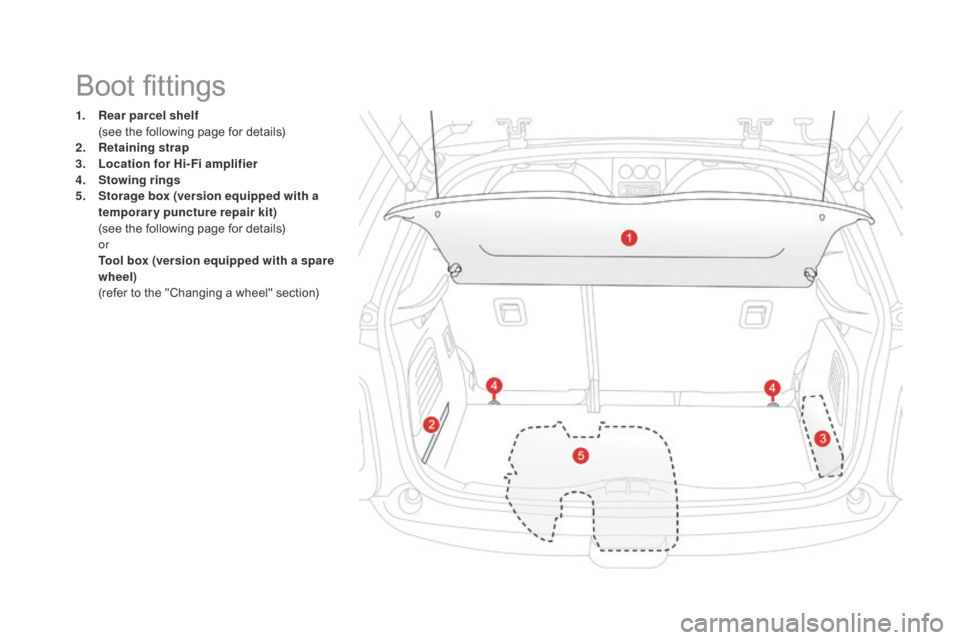
1. Rear parcel shelf (
see the following page for details)
2.
R
etaining strap
3.
L
ocation for Hi-Fi amplifier
4.
S
towing rings
5.
S
torage box (version equipped with a
temporary puncture repair kit)
(
see the following page for details)
or
T
ool box (version equipped with a spare
wheel)
(
refer to the "Changing a wheel" section)
Boot fittings
Page 103 of 387

101
To remove the shelf:
F u nhook the two cords,
F
r
aise the shelf slightly, then unclip it on
e
ach side.
Rear parcel shelf
F Raise the boot carpet by pulling the strap u
pwards to gain access to the storage box.
Storage box
F Refit the boot floor carpet by folding it s
lightly in the middle.
This
has
areas
for
storing
a
temporary
puncture
r
epair
kit,
a
box
of
spare
bulbs,
a
first
aid
kit,
t
wo
warning
triangles,
...
Comfort
Page 104 of 387

Driving
Page 105 of 387
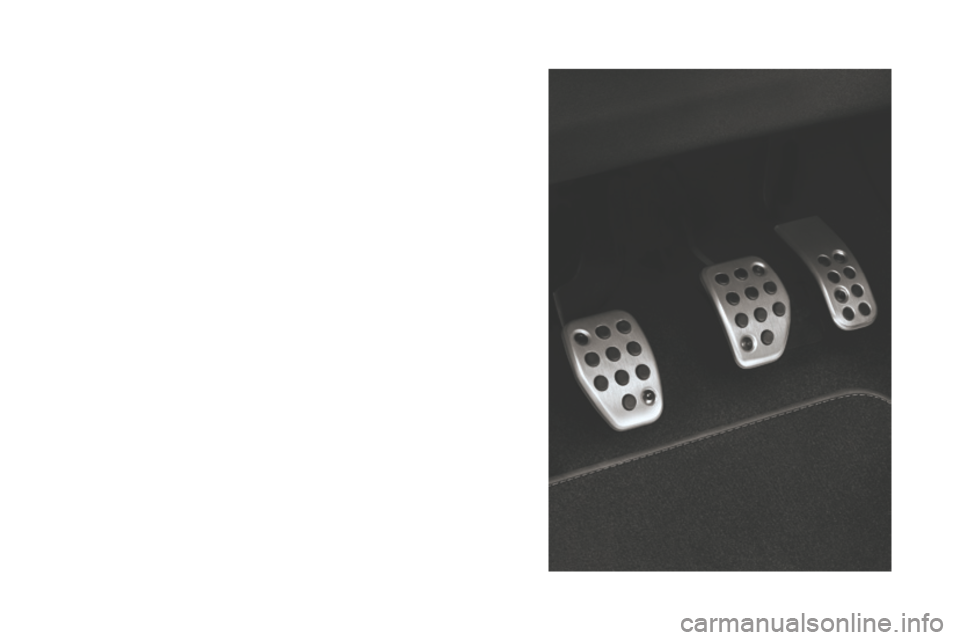
Page 106 of 387
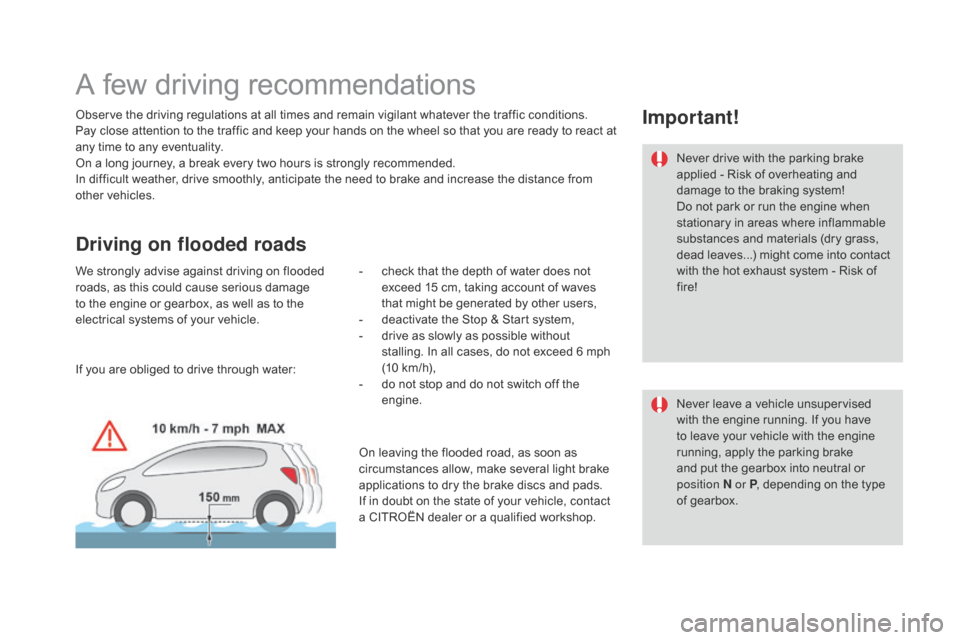
A few driving recommendations
Observe the driving regulations at all times and remain vigilant whatever the traffic conditions.
P ay close attention to the traffic and keep your hands on the wheel so that you are ready to react at
a
ny time to any eventuality.
On
a long journey, a break every two hours is strongly recommended.
In
difficult weather, drive smoothly, anticipate the need to brake and increase the distance from
o
ther
v
ehicles.
driving on flooded roads
We strongly advise against driving on flooded roads, as this could cause serious damage
t
o the engine or gearbox, as well as to the
e
lectrical systems of your vehicle.
Important!
Never drive with the parking brake applied - Risk of overheating and
d
amage to the braking system!
Do
not park or run the engine when
s
tationary in areas where inflammable
s
ubstances and materials (dry grass,
d
ead leaves...) might come into contact
w
ith the hot exhaust system - Risk of
f
ire!
Never
leave a vehicle unsupervised
w
ith the engine running. If you have
t
o leave your vehicle with the engine
r
unning, apply the parking brake
a
nd put the gearbox into neutral or
p
osition
n or P,
depending on the type
o
f gearbox.
-
c
heck
that
the
depth
of
water
does
not
e
xceed
15
cm,
taking
account
of
waves
t
hat
might
be
generated
by
other
users,
-
d
eactivate
the
Stop
&
Start
system,
-
d
rive
as
slowly
as
possible
without
s
talling.
In
all
cases,
do
not
exceed
6
mph
(
10 km/h),
-
d
o
not
stop
and
do
not
switch
off
the
e
ngine.
If
you
are
obliged
to
drive
through
water: On
leaving
the
flooded
road,
as
soon
as
c
ircumstances
allow,
make
several
light
brake
a
pplications
to
dry
the
brake
discs
and
pads.
If
in
doubt
on
the
state
of
your
vehicle,
contact
a
CITROËN
dealer
or
a
qualified
workshop.
Page 107 of 387

105
Anti-theft protection
Electronic engine immobiliser
The key contains an electronic chip which has a special code. When the ignition is switched
o
n, this code must be recognised in order for
s
tarting to be possible.
This
electronic engine immobiliser locks the
e
ngine management system a few moments
a
fter the ignition is switched off and prevents
s
tarting of the engine by anyone who does not
h
ave the key.In the event of a fault, you are
informed
by illumination of this
w
arning lamp, an audible signal and
a
message in the screen.It
has 3 positions:
-
P
osition 1: Stop
-
P
osition 2: Ignition on
-
P
osition 3: Starting
Ignition switch
Ignition on
In this position the vehicle's electrical equipment can be used or accessories
c
harged.
When
the state of charge of the battery
d
rops to a reserve level, the system goes into
e
nergy economy mode: the power supply is
a
utomatically cut off to preserve the state of
c
harge of the battery.
Keep
safely,
away
from
your
vehicle,
t
he
label
attached
to
the
keys
given
to
y
ou
on
acquisition
of
the
vehicle.
Starting-switching off the engine
In this case, your vehicle will not start; contact a CITROËN dealer as soon as possible.
Avoid
attaching heavy objects to the
k
ey, which would weigh down on its
b
lade in the ignition switch and could
c
ause a malfunction.
driving
Page 108 of 387
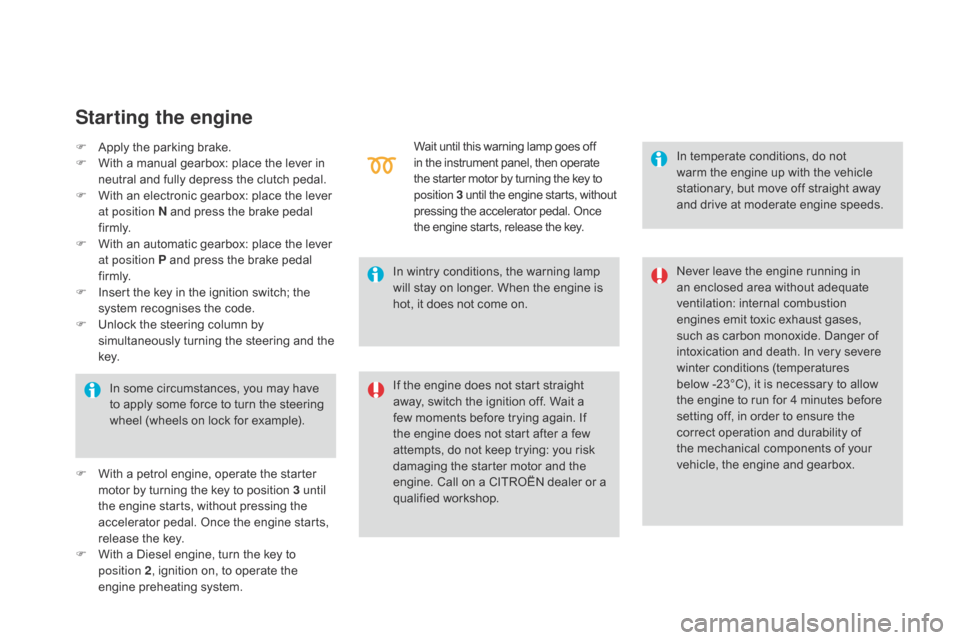
F Apply the parking brake.
F W ith a manual gearbox: place the lever in
n
eutral and fully depress the clutch pedal.
F
W
ith an electronic gearbox: place the lever
a
t position n and press the brake pedal
f
i r m l y.
F
W
ith an automatic gearbox: place the lever
a
t position P and press the brake pedal
f
i r m l y.
F
I
nsert the key in the ignition switch; the
s
ystem recognises the code.
F
U
nlock the steering column by
s
imultaneously turning the steering and the
k
ey.
Starting the engine
In some circumstances, you may have to apply some force to turn the steering
w
heel (wheels on lock for example).In
wintry conditions, the warning lamp
w
ill stay on longer. When the engine is
h
ot, it does not come on.In temperate conditions, do not
w
arm the engine up with the vehicle
s
tationary, but move off straight away
a
nd drive at moderate engine speeds.
If the engine does not start straight a
way, switch the ignition off. Wait a
f
ew moments before trying again. If
t
he engine does not start after a few
a
ttempts, do not keep trying: you risk
d
amaging the starter motor and the
e
ngine. Call on a CITROËN dealer or a
q
ualified
w
orkshop.Never
leave the engine running in
a
n enclosed area without adequate
v
entilation:
in
ternal
c
ombustion
e
ngines emit toxic exhaust gases,
s
uch as carbon monoxide. Danger of
i
ntoxication and death. In very severe
w
inter conditions (temperatures b
elow -23°C), it is necessary to allow t
he engine to run for 4 minutes before
s
etting off, in order to ensure the
c
orrect operation and durability of
t
he mechanical components of your
v
ehicle, the engine and gearbox.
F
W
ith a petrol engine, operate the starter
m
otor by turning the key to position 3 until
the
engine starts, without pressing the
a
ccelerator pedal. Once the engine starts,
r
elease the key.
F
W
ith a Diesel engine, turn the key to
p
osition 2 ,
ignition on, to operate the
eng
ine
p
reheating
s
ystem. Wait
until this warning lamp goes off
i
n the instrument panel, then operate
t
he starter motor by turning the key to
p
osition
3
until the engine starts, without
p
ressing the accelerator pedal. Once
t
he engine starts, release the key.
Page 109 of 387
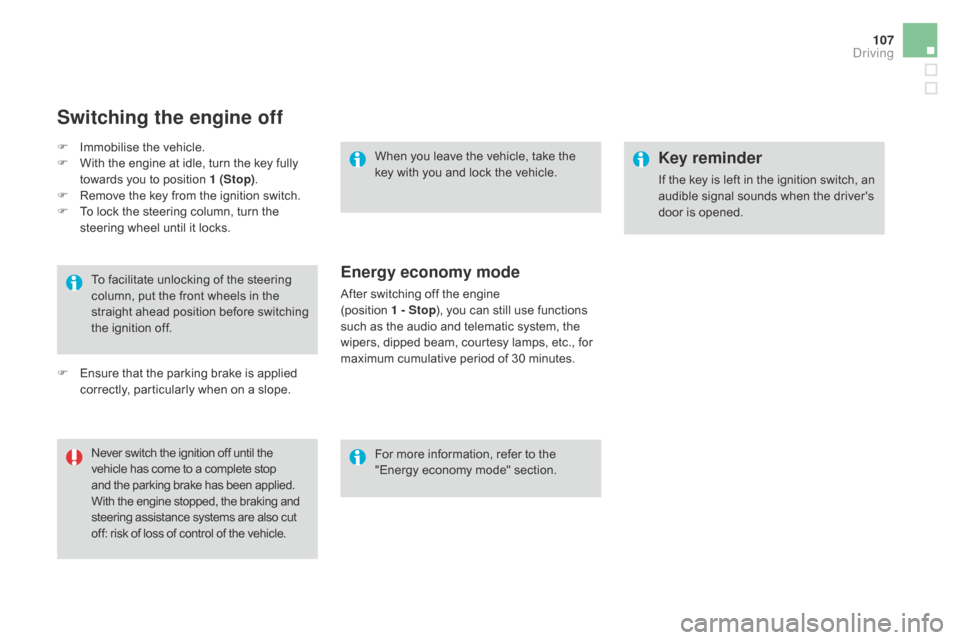
107
To facilitate unlocking of the steering column, put the front wheels in the
s
traight
a
head
p
osition
b
efore
s
witching
t
he ignition off.
Never
switch the ignition off until the
v
ehicle has come to a complete stop
a
nd the parking brake has been applied.
W
ith the engine stopped, the braking and
s
teering assistance systems are also cut
o
ff: risk of loss of control of the vehicle.When
you leave the vehicle, take the
k
ey with you and lock the vehicle.
For more information, refer to the
"
Energy economy mode" section.
Key reminder
If the key is left in the ignition switch, an audible signal sounds when the driver's
d
oor is opened.
Switching the engine off
F Immobilise the vehicle.
F W ith the engine at idle, turn the key fully
t
owards you to position 1 (Stop).
F
R
emove the key from the ignition switch.
F
T
o lock the steering column, turn the
s
teering wheel until it locks.
F
E
nsure that the parking brake is applied
c
orrectly, particularly when on a slope.
Energy economy mode
After switching off the engine (position 1
- Stop),
you can still use functions
s
uch as the audio and telematic system, the
w
ipers, dipped beam, courtesy lamps, etc., for
m
aximum cumulative period of 30 minutes.
driving
Page 110 of 387

Parking brake
Applying
F Pull the parking brake lever fully up to i
mmobilise your vehicle.
Releasing
F Pull the parking brake lever gently, press t
he release button then lower the lever
fully.
When
parking on a slope, direct your
w
heels against the pavement, apply the
p
arking brake and engage a gear.
When
the vehicle is being driven, if this
w
arning lamp and the STOP
w
arning
l
amp come on, accompanied by an
a
udible signal and a message in the multifunction
s
creen, this indicates that the parking brake is still
o
n or has not been properly released.